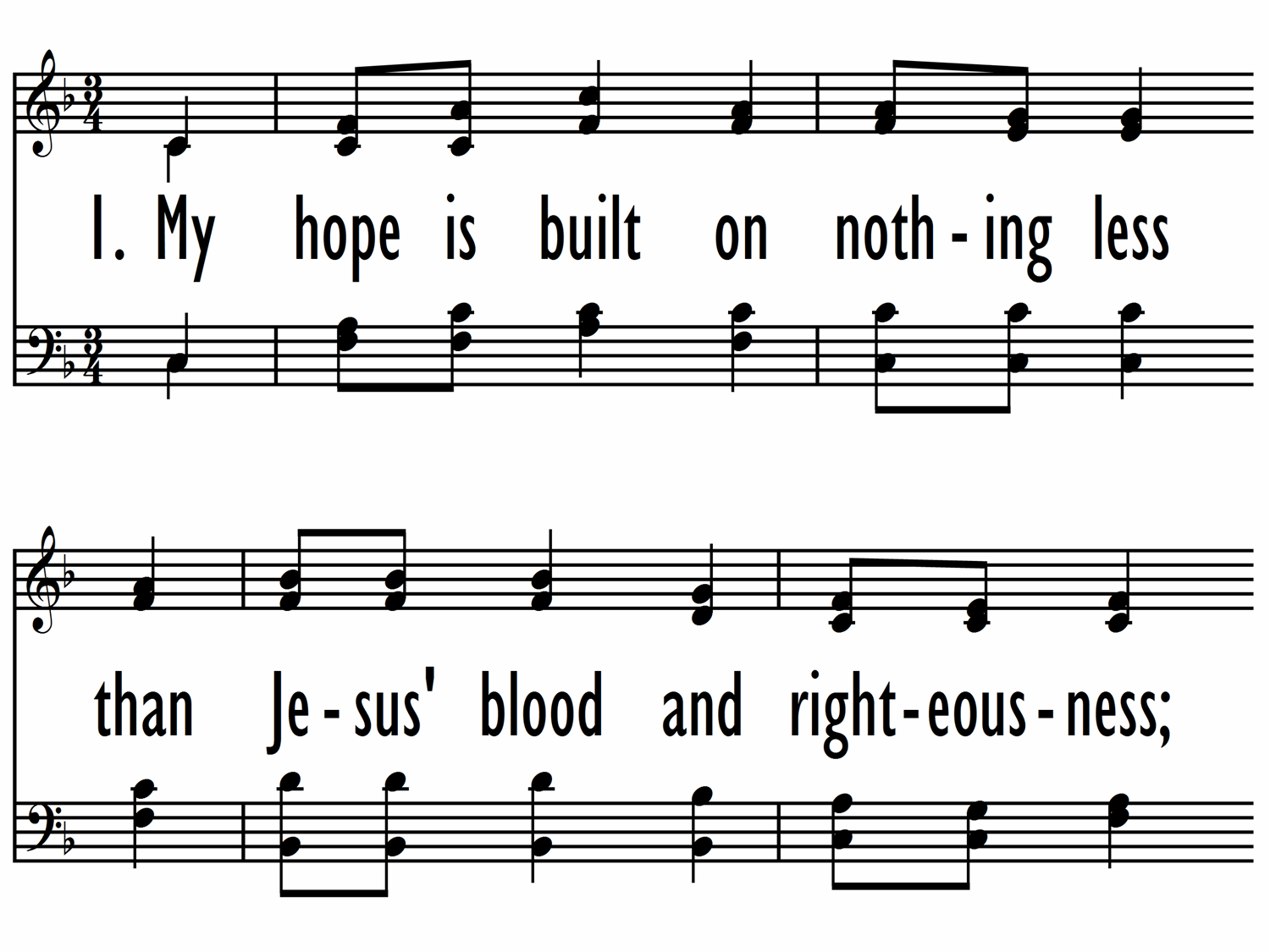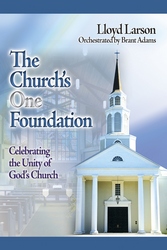- |
User Links
772
My Hope Is Built on Nothing Less
Hymn Information
- First Line
- My hope is built on nothing less
- Author
- Edward Mote, 1797-1894
- Tune Name
- SOLID ROCK
- Composer
- William B. Bradbury, 1816-1868
- Topic
- Darkness · Eternal Life · Hope · Jesus Christ: Blood of · Jesus Christ: Second Coming · Jesus Christ: Solid Rock · Testimony/Witness · Trust in God · Unity and Fellowship · Elements of Worship: Profession of Faith
Copyright Information
- Text Copyright
- Public Domain
- Tune Copyright
- Public Domain
- Reprint/Projection Information
- Words and Music: The Words and Music are in the Public Domain; you do not need permission to project or reprint the Words and Music.
Full Text
Scripture References
Confessions and Statements of Faith References
Further Reflections on Confessions and Statements of Faith References
The Christology of the song, “My Hope Is Built on Nothing Less” is carefully based on the content of the Apostles’ Creed, and the firmness of the convictions here echo the words of Belgic Confession, Article 20, that God gave “his Son to die, by a most perfect love, and [raised] him to life for our justification, in order that by him we might have immortality and eternal life.” “When [his] benefits are made ours, they are more than enough to absolve us of our sins…(Additionally,) the Holy Spirit kindles in our hearts a true faith that embraces Jesus Christ, with all his merits, and makes him its own, and no longer looks for anything apart from him” (Belgic Confession, Article 22).
772
My Hope Is Built on Nothing Less
Additional Prayers
A Prayer of Acclamation with Response Said or Sung
Lord Jesus Christ, the idols of this age are glitter and dust, but you are our rock.
On Christ, the solid rock, I stand.
On Christ, the solid rock, I stand.
The idols of the mind are appearance and mirage, but you are our rock.
On Christ, the solid rock, I stand.
On Christ, the solid rock, I stand.
The idols of the marketplace are in fashion and out of fashion, but you are our rock.
On Christ, the solid rock, I stand.
On Christ, the solid rock, I stand.
Lord Jesus Christ, the idols of this age collapse when people cling to them, but you are our rock.
On Christ, the solid rock, I stand. All other ground is sinking sand. All other ground is sinking sand. Amen.
On Christ, the solid rock, I stand. All other ground is sinking sand. All other ground is sinking sand. Amen.
—
Cornelius Plantinga, Jr.
772
My Hope Is Built on Nothing Less
Tune Information
- Name
- SOLID ROCK
- Key
- F Major
- Meter
- 8.8.8.8 refrain 8.8.8
Recordings
772
My Hope Is Built on Nothing Less
Hymn Story/Background
As Edward Mote was walking to work one day in 1834, the thought popped into his head to write a hymn on the “Gracious Experience of a Christian.” As he walked up the road, he had the chorus, “On Christ, the solid Rock, I stand; All other ground is sinking sand.” By the end of the day, he had the first four verses written out and safely tucked away in his pocket. Later that week, he visited his friend whose wife was very ill, and as they couldn’t find a hymnal to sing from, he dug up his newly written verses and sang those with the couple. The wife enjoyed them so much she asked for a copy, and Mote went home to finish the last two verses and sent it off to a publisher, saying, “As these verses so met the dying woman’s case, my attention to them was the more arrested, and I had a thousand printed for distribution” (Lutheran Hymnal Handbook). Almost two centuries later, we continue to sing these words of hope and assurance, our declaration that in the midst of all trials and storms, we will cling to the rock that is our Savior.
—
Laura de Jong
Edward Mote is among the first to use the term “gospel hymn,” as this text of his sets out the pattern used by many later gospel hymns: two couplets with related ideas in stanzas and then a refrain. In this case the text draws on powerful imagery from Jesus’ parable of building a house on rock rather than sand. Sometimes known as “the father of Sunday school hymnody,” Bradbury composed the tune specifically for this text while the United States was suffering through its Civil War.
—
Bert Polman
The Sunday school hymn writer William B. Bradbury composed SOLID ROCK in 1863 for Edward Mote's "My Hope Is Built on Nothing Less." The tune name derives from that song's refrain: "On Christ, the solid rock, I stand. . . .” Bradbury published SOLID ROCK in his 1864 children's collection The Golden Censor. The tune exhibits a bar form (AAB) with a coda added to its final line, allowing a repeat of the final phrase in the versification. The final line was originally the refrain line in Mote's gospel hymn. SOLID ROCK is well-suited to singing in harmony; festival use of instruments other than organ heightens the thanksgiving mood of the psalm text.
—
Bert Polman
Author Information
Edward Mote (1797-1974) was born in Upper Thames Street in London. Through the preaching of the Reverend J. Hyatt, of Tottenham Court Road Chapel, he underwent a great spiritual change and ultimately he became a Baptist minister. For the last 26 years of his life he was pastor at Horsham, Sussex. Mote publishe several small pamphlets as well as Hymns of Praise: a New Selection of Gospel Hymns, combining all the Excellencies of our spiritual Poets, with many Originals. By E. Mote. London. J. Nichols, 1836. The Originals number nearly 100.
Composer Information
Bradbury came from a musical family who encouraged him from an early age to learn to play various musical instruments. In 1830 his family moved to Boston. There he studied singing with Lowell Mason and sang in Mason's Bowdoin Street Church choir. In 1841 Bradbury moved to Brooklyn, New York, and became the organist at the Baptist Tabernacle in New York City. He organized children's singing classes, which developed into annual singing festivals and stimulated the teaching of music in the New York public schools. In 1854 William joined his brother Edward and a German piano maker to begin a piano firm, which became the Bradbury Piano Company. Bradbury wrote or edited sixty collections of popular music and edited and published numerous song books, including The Psalmodist (1844) and Golden Shower of Sunday School Melodies (1862). He is sometimes known as "the father of Sunday school hymnody."
—
Bert Polman
Suggestions or corrections? Contact us


 My Starred Hymns
My Starred Hymns






